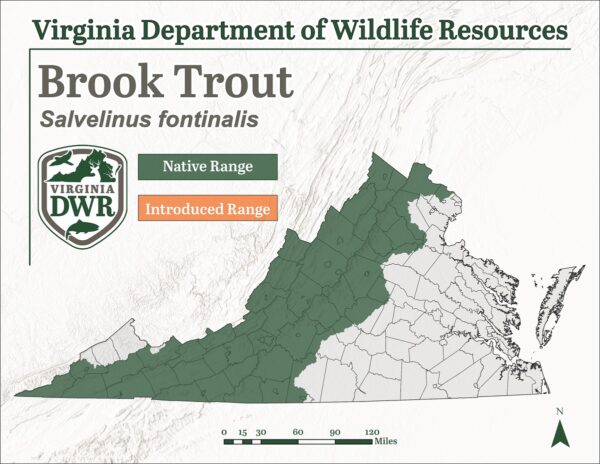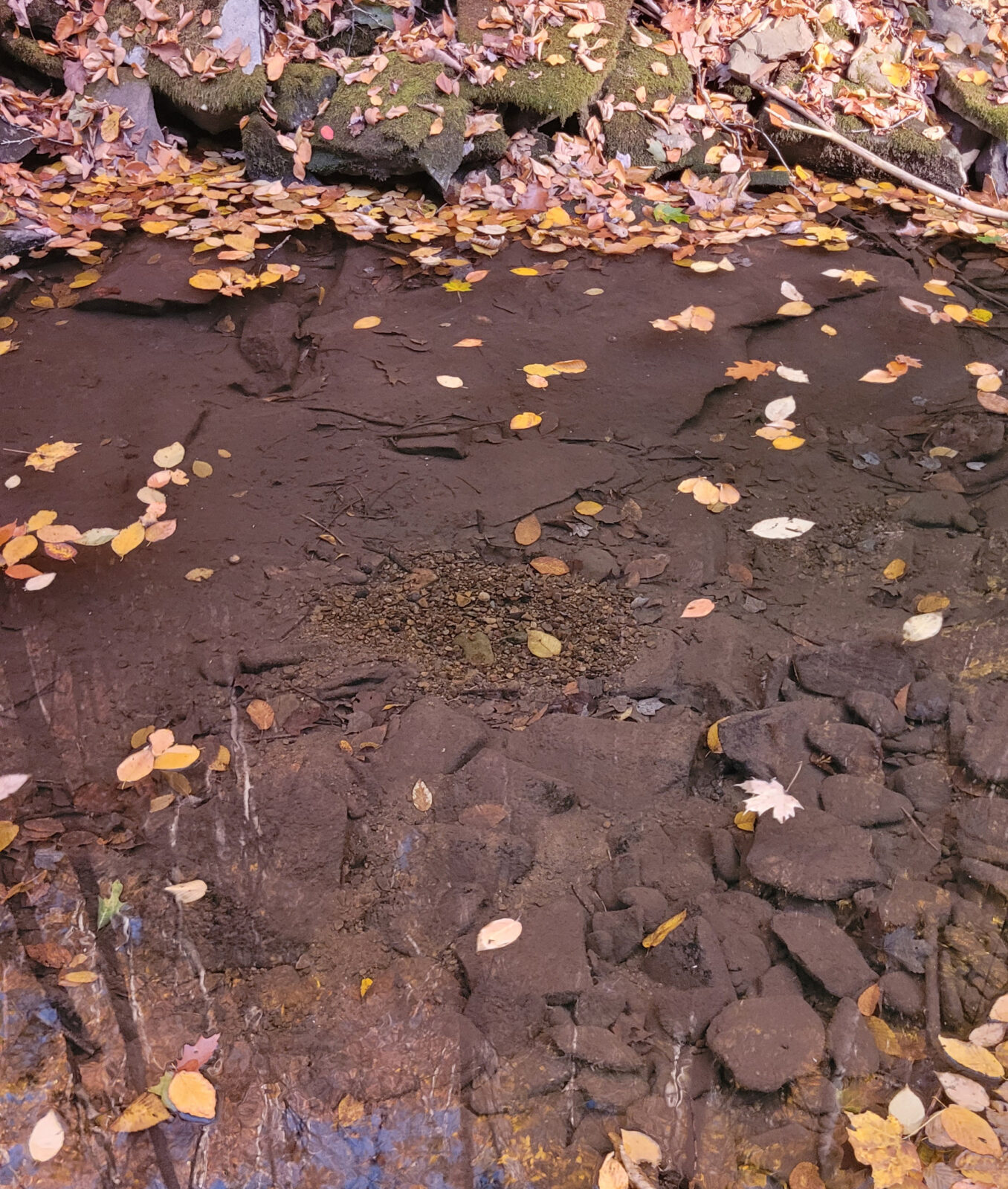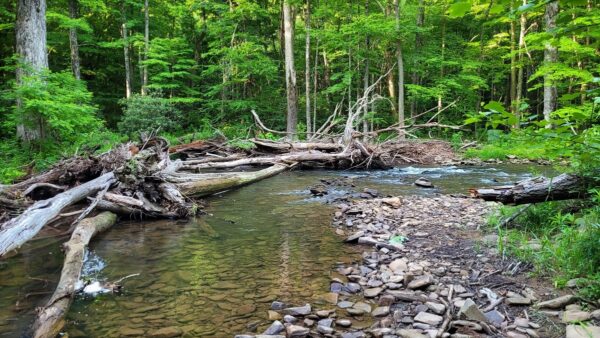A small coldwater stream, depicting where Brook Trout are most commonly found in Virginia.
An angler displays a Brook Trout caught while fly fishing.
Fact File
Scientific Name: Salvelinus fontinalis
Classification: Fish, Order Salmoniformes, Family Salmonidae
Conservation Status:
- SGCN Tier IVa: The Virginia 2015 Wildlife Action Plan lists Brook Trout as a Species of Greatest Conservation Need (SGCN) in Tier IV, with a conservation opportunity ranking of "a"
- State Freshwater Fish of Virginia
Size: Brook Trout in Virginia typically range from 6 to 12 inches in length
Life Span: Brook Trout live to an average of 3 to 4 years in Virginia
Identifying Characteristics

An adult Brook Trout collected in Virginia’s Blue Ridge Mountains. ©DCR Healthy Waters Program / VCU INSTAR
- Pale colored spots on a dark olive background along the body
- Worm-like vermiculation patterned along the dorsal (back)
- Red-orange fins with white leading edges
- Red spots throughout the body, many of which are encircled by a blue halo
- Adipose fin
How to Discern from Similar Looking Species:
Brown Trout Salmo trutta
- Brook Trout have vermiculations along their dorsal. These are worm-like patterns that will be absent in Brown Trout
- Brown Trout lack the white and black leading edges on their pectoral, pelvic, and anal fins that Brook Trout possess
Rainbow Trout Oncorhynchus mykiss
- Rainbow Trout have prominent and uniform spots throughout their dorsal and caudal fins, Brook Trout do not
- Rainbow Trout will often have white tips on their fins, but they will lack the prominent black edge found on the fins of Brook Trout
Diet
Brook Trout are opportunistic feeders. Their diet is most often comprised of subsurface macroinvertebrates, but they will also target adult aquatic insects, terrestrial insects, other fish, and even small amphibians and mammals when the opportunity presents itself.
Distribution
Brook Trout are native to the headwaters of the James, New, Potomac, Rappahannock, and Tennessee River systems in Virginia.

Habitat
Brook Trout require pristine water that is both cold and highly oxygenated. They prefer to inhabit sections of stream with cover in the form of large woody debris, root wads, undercut banks, and forested canopies.
Brook Trout prefer clean substrates void of sedimentation where they can prey on one of their primary food sources, benthic macroinvertebrates. Brook Trout compete in a hierarchy for the aforementioned resources, with dominant individuals claiming locations that provide a combination of the best protective cover and feeding opportunities.

A healthy Brook Trout observed underwater, occupying an area of stream with low sedimentation. ©Reuben Browning
Reproduction
In Virginia, Brook Trout can spawn from late September through December. The ritual is prompted by diminishing daylight hours and falling water temperatures, but can vary depending on the elevation of a particular site as well as annual climactic variances.
Leading up to a spawning event, Brook Trout will display a more vibrant color variant than is typically observed at other times of the year. Females will become visibly engorged in the abdomen with the presence of eggs. Males often develop a deeper body profile, along with a hooked lower jaw called a kype, both of which are used to intimidate and spar with other males for the privilege to breed.
When conditions are right, female Brook Trout will migrate throughout a stream in search of pool tail-outs comprised of spawning substrates, which are ideally comprised of gravels ranging from pea to golf ball in size, with minimal levels of silt. After they’ve selected a spawning site, the females use their fins to excavate nests, which are termed redds within the substrate.

A Brook Trout begins to seek out spawning substrates. ©Reuben Browning
Males in search of a mate will compete amongst each other in an attempt to pair with a female on a redd. If the female is receptive, she will release her eggs within the redd for the successful male to fertilize. Once the eggs are fertilized and spawning is complete, the female will move upstream and cover the eggs with additional substrate materials for added protection.

A completed Brook Trout redd (center frame) in a small mountain stream.
The eggs stay incubated within the redd throughout the winter, and require a consistent flow of clean oxygenated water during this time. In Virginia, eggs hatch from mid-January through February. During this time period we ask all Virginia anglers to take extra precaution when recreating on streams where Brook Trout are spawning or eggs may be present.
Threats to Brook Trout in Virginia
- Competition with non-native species
- Increasing water temperatures associated with climate change and a lack of riparian canopy
- Predation from non-native species
- Sedimentation due to poor land-use practices and/or development
- Water quality impairment
Last updated: June 26, 2024
The Virginia Department of Wildlife Resources Species Profile Database serves as a repository of information for Virginia’s fish and wildlife species. The database is managed and curated by the Wildlife Information and Environmental Services (WIES) program. Species profile data, distribution information, and photography is generated by the Virginia Department of Wildlife Resources, State and Federal agencies, Collection Permittees, and other trusted partners. This product is not suitable for legal, engineering, or surveying use. The Virginia Department of Wildlife Resources does not accept responsibility for any missing data, inaccuracies, or other errors which may exist. In accordance with the terms of service for this product, you agree to this disclaimer.


